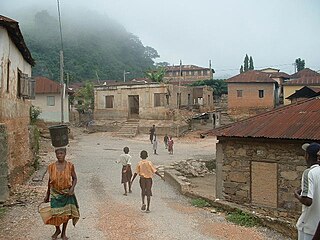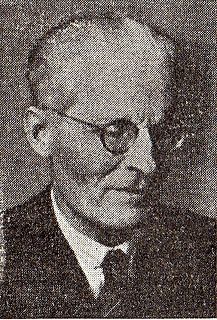Related Research Articles

Franz Miklosich was a Slovene philologist.

August Schleicher was a German linguist. His great work was A Compendium of the Comparative Grammar of the Indo-European Languages in which he attempted to reconstruct the Proto-Indo-European language. To show how Indo-European might have looked, he created a short tale, Schleicher's fable, to exemplify the reconstructed vocabulary and aspects of Indo-European society inferred from it.
The Kalenjin languages are a family of a dozen Southern Nilotic languages spoken in Kenya, eastern Uganda and northern Tanzania. The term Kalenjin comes from an expression meaning "I say " or "I have told you". Kalenjin in this broad linguistic sense should not be confused with Kalenjin as a term for the common identity the Nandi-speaking peoples of Kenya assumed halfway through the twentieth century; see Kalenjin people and Kalenjin language.
Pökoot is a language spoken in western Kenya and eastern Uganda by the Pokot people. Pökoot is classified to the northern branch of the Kalenjin languages found in Kenya, Uganda, and Tanzania. The Pökoot are usually called "Kimukon" by the other Kalenjin peoples. A 1994 figure of SIL puts the total number of speakers at 264,000, while the only little more recent Schladt (1997:40) gives the more conservative estimate of 150,000 people, presumably based on the figures found in Rottland (1982:26) who puts the number at slightly more than 115,000.

Carl Eduard Sachau was a German orientalist.

Otto Dempwolff was a German physician, linguist and anthropologist who specialized in the study of the Austronesian language family.

The Ghana–Togo Mountain languages, formerly called Togorestsprachen and Central Togo languages, form a grouping of about fourteen languages spoken in the mountains of the Ghana–Togo borderland. They are part of the Kwa branch of the Niger–Congo family.
The Zipser Germans or Zipsers are a German-speaking ethnic group which developed in the Szepes County of Upper Hungary—today mostly Slovakia—as that region was settled by people from central Germany beginning in the 13th century. Beginning in at least the 18th century, many members of the ethnic group migrated to southern Bukovina, Maramuresch, and Transylvania. Former Slovak President Rudolf Schuster is partly Zipser German.
Friedrich (von) Spiegel was a German orientalist. He was one of the pioneers in the field of Iranian philology.
Berti is an extinct Saharan language formerly spoken in northern Sudan, specifically in the Tagabo Hills, Darfur, and Kurdufan. Berti speakers migrated into the region with other Nilo-Saharan speakers, such as the Masalit and Daju, who were agriculturalists practicing varying degrees of animal husbandry. They settled in two separate areas: one north of Al-Fashir, while the other had continued eastward, settling in eastern Darfur and western Kurdufan by the nineteenth century. The two groups did not appear to share a common identity, the western group differing noticeably in its cultivation of gum arabic. By the 1990s, Arabic had largely replaced Berti as a native language.
Animere is a language spoken in Ghana, in the Kecheibe and Kunda villages of the Benimbere people. It is most closely related to Kebu or Akebu of Togo. Both are Ghana Togo Mountain languages (GTM), classified as members of the Ka-Togo group by Heine (1968). Like most other GTM languages, Animere is a noun-class language.
Boro is an extinct language once spoken in central eastern Ghana. In the vicinity of Worawora and Tapa, Rudolf Plehn found one old man who could still remember some words of this language, which according to him was spoken by more people in his younger years. The language is only known from the 12 lexical items collected by Plehn around the end of the 19th century and published in Seidel (1898). Westermann (1922) classified it as one of the Togorestsprachen, a classification followed by Glottolog, while Heine (1968:300) leaves it unclassified.
Georg Renatus Solta was an Austrian Indo-Europeanist who specialized in Balkan linguistics.
Semitic studies, or Semitology, is the academic field dedicated to the studies of Semitic languages and literatures and the history of the Semitic-speaking peoples. A person may be called a Semiticist or a Semitist, both terms being equivalent.
Siwu is spoken in the mountainous central part of the Volta Region of Ghana. It belongs to the geographic group of Ghana Togo Mountain languages of the Kwa branch of Niger–Congo. The speakers of Siwu call themselves the Mawu and their land Kawu.
The four Mba languages form a small family of Ubangian languages scattered across the northern Democratic Republic of the Congo. The languages are,

Roderich von Erckert was a German ethnographer and officer. His work on the Caucasian languages includes Der Kaukasus und seine Völker ; Die Sprachen des kaukasischen Stammes ; and Wanderungen und Siedelungen der germanischen Stämme in Mitteleuropa.
The Indo-Semitic hypothesis maintains that a genetic relationship exists between Indo-European and Semitic and that the Indo-European and the Semitic language families descend from a prehistoric language ancestral to them both. The theory has never been widely accepted by contemporary linguists in modern times, but historically it has had a number of supporting advocates and arguments, particularly in the 19th and 20th centuries.

Jooseppi Julius Mikkola, was Finnish linguist and professor. Mikkola is regarded as one of the most important Finnish linguists of Slavic languages of his era.

Pala was a Bronze Age country in Northern Anatolia. Nothing more is known about Pala than its native language, which is the Palaic language (palaumnili), and its native religion. The only person known who is of Palaic origin is a ritual priestess Anna.